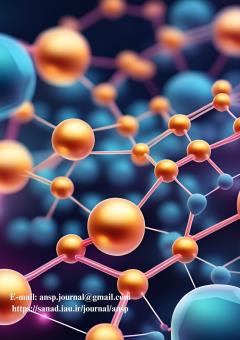Synthesis and Characterization of Cellulose Nanocrystal-Grafted poly(2-dimethylaminoethyl methacrylate) with application in Ion removal from aqueous solutions
Subject Areas : Applied smart materialsMojtaba Azizi 1 , Milad Aghazadeh Bonab 2 , Seyed Mahdi Saedi 3
1 - Faculty of Chemistry and Chemical Engineering, Malek Ashtar University of Technology, P.O. Box 16765-3454,Tehran, Iran
2 -
3 -
Keywords: Water-treatment, Nitrate ion removal, CNC, RAFT, Smart polymers,
Abstract :
This study focuses on the synthesis and characterization of poly(2-dimethylaminoethyl methacrylate) (PDMAEMA) grafted onto cellulose nanocrystals (CNC) using reversible addition-fragmentation chain transfer (RAFT) polymerization. The main goal was to assess the efficacy of CNC-g-PDMAEMA as a material for the removal of ionic pollutants, specifically nitrate ions, from water solutions. The functionalization of CNC with PDMAEMA has been confirmed using Fourier-transform infrared (FTIR) spectroscopy, thermogravimetric analysis (TGA), and UV-Vis spectroscopy. Results indicated that CNC-g-PDMAEMA demonstrates pH-responsive characteristics, wherein the protonation of amino groups dramatically enhances electrostatic interactions with nitrate ions, thereby increasing adsorption efficiency. The efficacy of nitrate ion extraction as our pollutant from aqueous solutions was examined, demonstrating the material's superior adsorption capability. This research illustrates the efficacy of stimuli-responsive nanoparticles in water treatment, providing an environmentally sustainable method for the elimination of aqueous ionic contaminants and improving water purification procedures.
[1] M. Choudhary, M. Muduli, and S. Ray, “A comprehensive review on nitrate pollution and its remediation: conventional and recent approaches,” Sustain. Water Resour. Manag., vol. 8, no. 4, pp. 1–25, 2022, doi: 10.1007/s40899-022-00708-y.
[2] A. Maleki, M. Mohammad, Z. Emdadi, N. Asim, M. Azizi, and J. Safaei, “Adsorbent materials based on a geopolymer paste for dye removal from aqueous solutions,” Arab. J. Chem., vol. 13, no. 1, pp. 3017–3025, 2020, doi: 10.1016/j.arabjc.2018.08.011.
[3] م. عزیزی, م. ا. زاده, ع. عبدالملکی, and ف. رشیدی, “شبیه سازی، بهینه سازی بررسی فنی و اقتصادی تصفیه پساب فلزات سنگین سمی به روش تخلیه صفر مایع (ZLD),” ماهنامه رهیافتی در مدیریت نفت و گاز, vol. 5, no. 3, pp. 1–20, 2023.
[4] M. Azizi, “Numerical investigation of the effect of periodic turbulence promoters on the performance enhancement of nanofiltration modules,” vol. 11, no. 3, pp. 46–60, 2025, doi: 10.22055/jhs.2024.47885.1321.
[5] M. Mehdi Salehi et al., “Chlorpyrifos and diazinon elimination through pAAm-g-XG/HKUST-1@Fe3O4 biopolymer nanoadsorbent hydrogel from wastewater: Preparation, characterization, kinetics and isotherm,” Sep. Purif. Technol., vol. 334, no. October 2023, p. 126097, 2024, doi: 10.1016/j.seppur.2023.126097.
[6] M. Azizi, M. Naderi, and A. Kargari, “CFD study of applying flow turbulence promoter for enhancing flux in nanofiltration process .,” pp. 1–8.
[7] Z. Abousalman-Rezvani, H. Roghani-Mamaqani, H. Riazi, and O. Abousalman-Rezvani, “Water treatment using stimuli-responsive polymers,” Polym. Chem., vol. 13, no. 42, pp. 5940–5964, 2022, doi: 10.1039/d2py00992g.
[8] P. Eskandari, H. Roghani-mamaqani, M. Salami-kalajahi, and Z. Abousalman-rezvani, “Modi fi cation of cellulose nanocrystal with dual temperature- and CO 2 - responsive block copolymers for ion adsorption applications,” vol. 310, pp. 13–15, 2020.
[9] Z. Abousalman-Rezvani, P. Eskandari, H. Roghani-Mamaqani, and M. Salami-Kalajahi, “Synthesis of coumarin-containing multi-responsive CNC-grafted and free copolymers with application in nitrate ion removal from aqueous solutions,” Carbohydr. Polym., vol. 225, no. August, 2019, doi: 10.1016/j.carbpol.2019.115247.
[10] Z. Abousalman-Rezvani, P. Eskandari, H. Roghani-Mamaqani, H. Mardani, and M. Salami-Kalajahi, “Grafting light-, temperature, and CO2-responsive copolymers from cellulose nanocrystals by atom transfer radical polymerization for adsorption of nitrate ions,” Polymer (Guildf)., vol. 182, no. August, p. 121830, 2019, doi: 10.1016/j.polymer.2019.121830.
[11] J. S. Karthika and B. Vishalakshi, “Novel stimuli responsive gellan gum-graft-poly(DMAEMA) hydrogel as adsorbent for anionic dye,” Int. J. Biol. Macromol., vol. 81, pp. 648–655, 2015, doi: 10.1016/j.ijbiomac.2015.08.064.
[12] Y. Bai, Y. N. Liang, and X. Hu, “An eco-friendly approach for heavy metal adsorbent regeneration using CO2-responsive molecular octopus,” Chemosphere, vol. 185, pp. 1157–1163, 2017, doi: 10.1016/j.chemosphere.2017.07.086.
[13] Z. Tajmoradi, H. Roghani-Mamaqani, and M. Salami-Kalajahi, “Cellulose nanocrystal-grafted multi-responsive copolymers containing cleavable o-nitrobenzyl ester units for stimuli-stabilization of oil-in-water droplets,” Chem. Eng. J., vol. 417, p. 128005, 2021, doi: 10.1016/j.cej.2020.128005.
[14] N. B. Tran, J. Y. Kim, Y. C. Kim, Y. J. Kim, and J. H. Kim, “CO2-responsive swelling behavior and metal-ion adsorption properties in novel histamine-conjugated polyaspartamide hydrogel,” J. Appl. Polym. Sci., vol. 133, no. 16, pp. 1–10, 2016, doi: 10.1002/app.43305.
[15] P. Lampman, K. Vyvyan, D. L. Pavia, and G. S. Kriz, Introduction to spectroscopy, 4th editio. 2009.
[16] B. Razavi, A. Abdollahi, H. Roghani-Mamaqani, and M. Salami-Kalajahi, “Light-, temperature-, and pH-responsive micellar assemblies of spiropyran-initiated amphiphilic block copolymers: Kinetics of photochromism, responsiveness, and smart drug delivery,” Mater. Sci. Eng. C, vol. 109, p. 110524, 2020, doi: 10.1016/j.msec.2019.110524.
[17] K. H. M. Kan, J. Li, K. Wijesekera, and E. D. Cranston, “Polymer-grafted cellulose nanocrystals as pH-responsive reversible flocculants,” Biomacromolecules, vol. 14, no. 9, pp. 3130–3139, 2013, doi: 10.1021/bm400752k.


